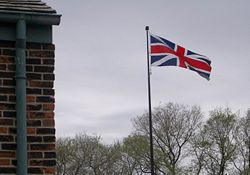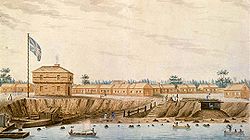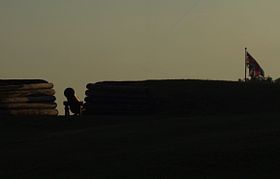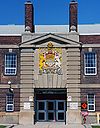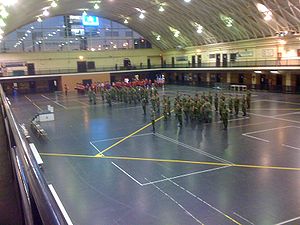- Fort York
-
This article is about the historic fort. For the current Canadian Forces facility, see Fort York Armoury. For the defunct Ontario Electoral District, see Fort York (electoral district).
Fort York 
Established 1793 Location Toronto, Ontario, Canada. Website fortyork.ca National Historic Site of CanadaDesignated: 1923 Fort York is a historic site of military fortifications and related buildings on the west side of downtown Toronto, Ontario, Canada. The fort was built by the British Army and Canadian militia troops in the late 18th and early 19th centuries, to defend the settlement and the new capital of the Upper Canada region from the threat of a military attack, principally from the newly independent United States. It was designated a National Historic Site of Canada in 1923.[1] [2]
Contents
Founding
In 1793, Lieutenant Governor John Graves Simcoe authorized a garrison on the present site of Fort York, just west of the mouth of Garrison Creek on the north eastern shore of Lake Ontario. Simcoe recognized Toronto was an ideal site for settlement and defence because of its natural harbour and relative longer distance from the United States. Fort York guards the western (at the time of construction, the only) entrance to the bay. Simcoe had decided to make Toronto (which he renamed York) the capital of Upper Canada, and the government, the first parliament buildings and the town were established one and a half miles east of the fort (near the foot of the present Parliament Street).
Buildings
In 1797 a garrison was built east of modern day Bathurst Street, on the east bank of Garrison Creek. This fort was destroyed in the Battle of York, 1813 (see below). Today's Fort York was largely built by Royal Engineers immediately after the war of 1812. The rebuilt Fort York is located on the original fort site west of Bathurst, at the time on the west bank of Garrison Creek. Fort York's buildings are among the oldest buildings in Toronto today. The original fort buildings were all wood, whereas the current structures are a mix of brick and wood.
A list of current structures at the fort:
- Stone Powder Magazine
- North and South Soldier Barracks
- Blockhouses 1 and 2
- Officer's Quarters
- Blue Barracks
- Brick Powder Magazine
Additional buildings located outside the fort were mainly star shaped blockhouses or magazines:
- Spadina Blockhouse 1838/1839-1860s - near College Street and Spadina Avenue (at present day Knox College)
- Sherbourne Blockhouse 1838/1839-1865 - Sherborne Avenue and Bloor Street
- Yonge Blockhouse at Belmont Street 1838/1839-1860s
The War of 1812 and after
During the War of 1812, on April 27, 1813 combined U.S. army and naval forces attacked York from Lake Ontario, overrunning Fort York (see Battle of York). As the British abandoned the fort, they set the powder magazine to blow up, killing or wounding several hundred U.S. soldiers (including General Zebulon Pike, for whom Pikes Peak is named). The explosion was heard as far away as Fort George,[citation needed] rivaled only by an explosion of black powder the British set off when they were unable to bring with them said powder in their retreat from Corunna under Moore around the same time in the Napoleonic campaign in Europe.[citation needed] The U.S. destroyed what was left of Fort York and burned much of the settlement of York, including the Parliament Buildings during their five–day occupation. They had defeated outnumbered British, Canadian, and First Nations forces, but with the loss of many more men. Following several more U.S. raids over the summer, the British garrison returned to York and rebuilt the fortifications, most of which are still standing today. The rebuilt fort was sufficient to repel a further attempted invasion in 1814.
The British Army occupied Fort York from 1793 to the 1850s and transferred it to Canada, which used it until 1932. However, the City of Toronto owned the Fort from 1903 onwards.
Fort York was used as a military establishment until 1880, and again during the First and Second World Wars.
Artillery
Fort York was defended by cannons on the west, north and south:
- 2 ~ 12 pounders - north side
- 1 ~ 14 pounder - west side
- 9 ~ 12 pounders - south side
Units
British
- 13th Hussars
- 19th Light Dragoons
- Royal Artillery
- Royal Engineers (Sappers and Miners)
- 1st Regiment of Foot
- 6th Regiment of Foot
- 8th Regiment of Foot
- 15th Regiment of Foot
- 16th Regiment of Foot
- 17th Regiment of Foot
- 23rd Regiment of Foot
- 24th Regiment of Foot
- 29th Regiment of Foot
- 30th Regiment of Foot
- 32nd Regiment of Foot
- 37th Regiment of Foot
- 41st Regiment of Foot
- 43rd Regiment of Foot
- 47th Regiment of Foot
- 49th Regiment of Foot
- 60th Regiment of Foot
- 66th Regiment of Foot
- 68th Regiment of Foot
- 70th Regiment of Foot
- 71st Regiment of Foot
- 73rd Regiment of Foot
- 76th Regiment of Foot
- 79th Regiment of Foot
- 81st Regiment of Foot
- 82nd Regiment of Foot
- 83rd Regiment of Foot
- 85th Regiment of Foot
- 89th Regiment of Foot
- 92nd Regiment of Foot
- 93rd Regiment of Foot
- 97th Regiment of Foot
- 100th Regiment of Foot
- Rifle Brigade
Canadian Militia
- Royal Newfoundland Regiment
- Glengarry Light Infantry
- Royal Canadian Rifle Regiment
- Queen's Rangers
- Royal Canadian Veteran Battalion
- Royal Canadian Volunteer Regiment
- 3rd Battalion Military Train
- York Militia
- Royal Canadian Dragoons
- HM Canadian Regiment of Fencible Infantry - current unit represented at the fort
- 7th Regiment
- 104th Regiment
- 6th Westmeath
- 26th Regiment
- 56th Regiment
- 103rd Regiment
- Royal Fusiliers
- New Brunswick Regiment
- Irish Militia Regiment
- Cameronians Regiment of Foot
- West Essex Regiment of Foot
- Regiment of Foot
- Marine and/Navy
- Canadian Voltigeurs
- Royal Canadian Artillery
- Royal Newfoundland Fencibles
- Military Train
- 2nd Battalion of Provisional Militia
- 3rd Battalion of Provisional Militia
- 6th Battalion of Provisional Militia
- 10th Royal Grenadiers
- 48th Highlanders of Canada
- Durham Militia
- Enrolled Pensioners
- Garrison Battery of Artillery
- Home Guards
- Incorporated Militia
- Queen's Lancers
- RCA Dragoons
- Toronto Cavalry
- York Militia and Colours
- Toronto Field Battery
Fort York National Historic Site
Fort York National Historic Site houses Canada's largest collection of original War of 1812 period buildings. The fort, operated as a museum of the City of Toronto, offers casual visitors and booked groups a number of exciting services year round. During the summer months, the site comes alive with the colour and the pageantry of the Fort York Guard and is complimented with tours by professional historical interpreters. In the off-season months, the fort is busy providing educational programs for booked tour groups including school, scout, guide, and day care groups.
In the 1950s Fort York was almost torn down to make way for the Gardiner Expressway, but Highway planners eventually rerouted the elevated highway to the south of the grounds.
The reclaimed lands to the south of the fort are in the process of being developed, with new condo towers eventually limiting any possible reconnection with Lake Ontario.
From 1995 to 2008, Fort York hosted Toronto's annual Festival of Beer.
Paranormal activity
Fort York is also known as a site with a fair amount of paranormal activity, which is presumably attributed to its military history (and the associated deaths which took place there when it was attacked on various occasions by American forces during the War of 1812). Visitors have reported peculiar noises on the grounds and in the buildings, as well as sightings of apparitions of soldiers.[citation needed]
Fort York Armoury
Main article: Fort York ArmouryThe southwest of Fort York is Fort York Armoury, a two–storey structure occupied by the Canadian Forces Primary Reserve; The Queen's York Rangers, The Royal Regiment of Canada, The Toronto Scottish Regiment (Queen Elizabeth the Queen Mother's Own), and the 709 (Toronto) Communication Regiment and formerly 2 Field Engineer Regiment and the 1st Battalion Irish Regiment. The building is a training facility for CF Reservists. In addition to being the headquarters of the four active units of the Army Reserve, the Armoury is also home to several thriving Cadet organizations.
The Armoury was built in 1933 with private funds and boasts the largest lattice wood arched roof in Canada. It was designed by Toronto architects Marani, Lawson and Morris.
There are three small regimental museums within the Armoury. Overlooking Lake Ontario there are a series of regimental Officers' Messes. These are excellent examples of the traditional British form. The exceptional architectural feature of Fort York Armoury is a parabolic Lamella roof. It provides an uninterrupted span of nearly 125 feet (38 m), roofing for parades, military vehicles and the training of soldiers. The main entrance to the Armoury has pilasters of rusticated masonry with a large carved coat-of-arms. This is the coat-of-arms of the Dominion of Canada. It appears above the flat keyed arch of the entrance. The cap badges of each original regiment are carved in stone set in the parapet over doorways opening to ornamental iron balconies.
Affiliations
The Museum is affiliated with: CMA, CHIN, and Virtual Museum of Canada.
See also
- New Fort York
- Fort York Armoury
- Trinity Bellwoods Park
- Fort Rouillé - The first fort to be established in Toronto (about 1 km West of Fort York)
- List of oldest buildings and structures in Toronto
- Chronology of the War of 1812
- War of 1812 Campaigns
- War of 1812
- Upper Canada
References
- Historic Fort York 1793-1993 by Carl Benn, National Heritage and National History Incorporated 1993
External links
- fortyork.ca - Friends of Fort York
- Historic photos from as far back as the 1890's
 Toronto
TorontoFeatures History Toronto Carrying-Place Trail · Fort Rouillé · Fort York · Toronto Purchase · York · Battle of York · Battle of Montgomery's Tavern · Great Fire of 1904 · Centennial of the City · Metro Toronto · Hurricane Hazel (effects) · Amalgamation of Toronto · Oldest buildings · National Historic Sites · Timeline · Former municipalitiesGeography Greater Toronto Area · Golden Horseshoe · Neighbourhoods (History) · Downtown · Parks · Waterfront · Harbour · Don River · Humber River · Rouge River · Toronto Islands · Leslie Street Spit · Scarborough Bluffs · Ravine system · Native trees · FaunaEconomy Politics Municipal government · Elections · City of Toronto Act · Mayors · City Council · City Hall (Toronto Government and Public Services) · CrimePublic Services Education Culture Attractions (Landmarks) · Architecture · Cinemas · Media outlets · Cuisine · Sports (Sports teams · Amateur sports) · Malls · Annual events · Films set in Toronto · Films shot in Toronto · Hollywood North · Let's All Hate TorontoPlaces of worship Churches in Toronto · Synagogues in TorontoTransportation Toronto Transportation Services · Port Authority · Pearson International Airport (in Mississauga) · Billy Bishop Airport · TTC · GO Transit · Metrolinx · Island Ferry · Roads (North–South · East–West) · Bridges · Cycling National Historic Sites of Canada by location
National Historic Sites of Canada by locationProvinces Territories Northwest Territories · Nunavut · YukonOther countries France History of Canada
History of CanadaTimeline - 18000 BCE–1500 CE
- 1534–1763
- 1763–1866
- 1867–1914
- 1914–1945
- 1945–1960
- 1960–1981
- 1982–1992
- 1992–present
Topics - Bibliography
- Constitutional
- Crown & Aboriginals
- Cultural
- Economic
- Etymology
- Events of significance
- Former colonies & territories
- Historic Sites
Immigration - Military - (Conflicts)
- Monarchical
- People of Canada - (Persons of significance)
- Population by year
- Territorial evolution
Provinces &
territoriesCities - Name etymologies
- Brampton
- Charlottetown
- Fredericton
- Halifax RM
- Hamilton
- Lethbridge
- Moncton
- Montreal
- Northwest Territories capital cities
- Ottawa
- Quebec City
- Regina
- Saskatoon
- Toronto
- Vancouver
- Winnipeg
Military history of North America Sovereign states Dependencies and
other territories- Anguilla
- Aruba
- Bermuda
- Bonaire
- British Virgin Islands
- Cayman Islands
- Curaçao
- Greenland
- Guadeloupe
- Martinique
- Montserrat
- Puerto Rico
- Saint Barthélemy
- Saint Martin
- Saint Pierre and Miquelon
- Saba
- Sint Eustatius
- Sint Maarten
- Turks and Caicos Islands
- United States Virgin Islands
Coordinates: 43°38′20.50″N 79°24′12″W / 43.639028°N 79.40333°W
Categories:- Living museums in Canada
- Museums in Toronto
- History of Toronto
- Forts in Ontario
- War of 1812 forts
- History museums in Canada
- Museums of the War of 1812
- Military and war museums in Canada
- National Historic Sites in Ontario
- Military forts in Ontario
Wikimedia Foundation. 2010.

